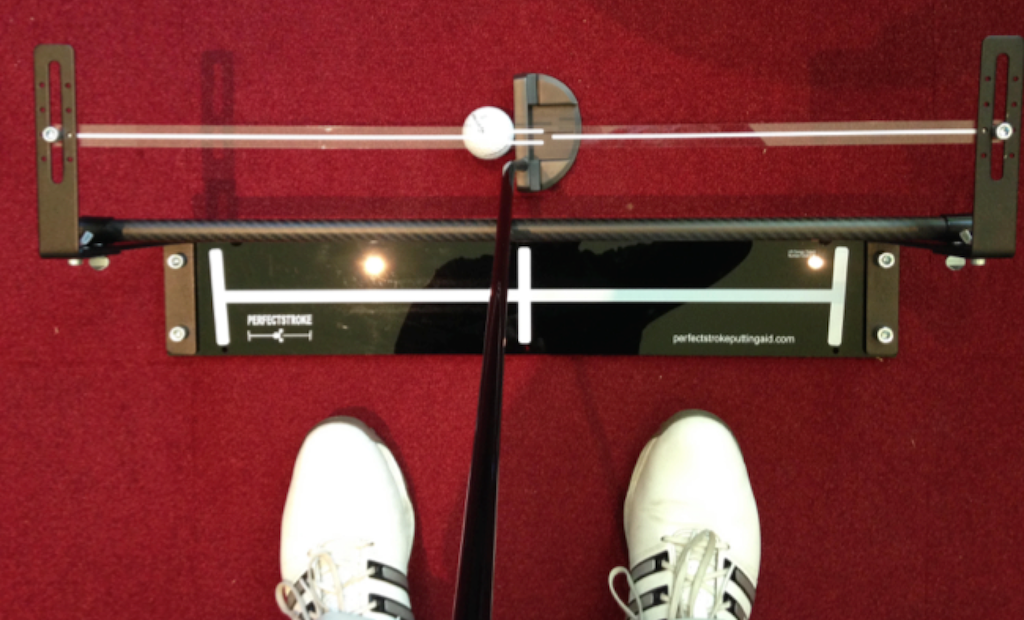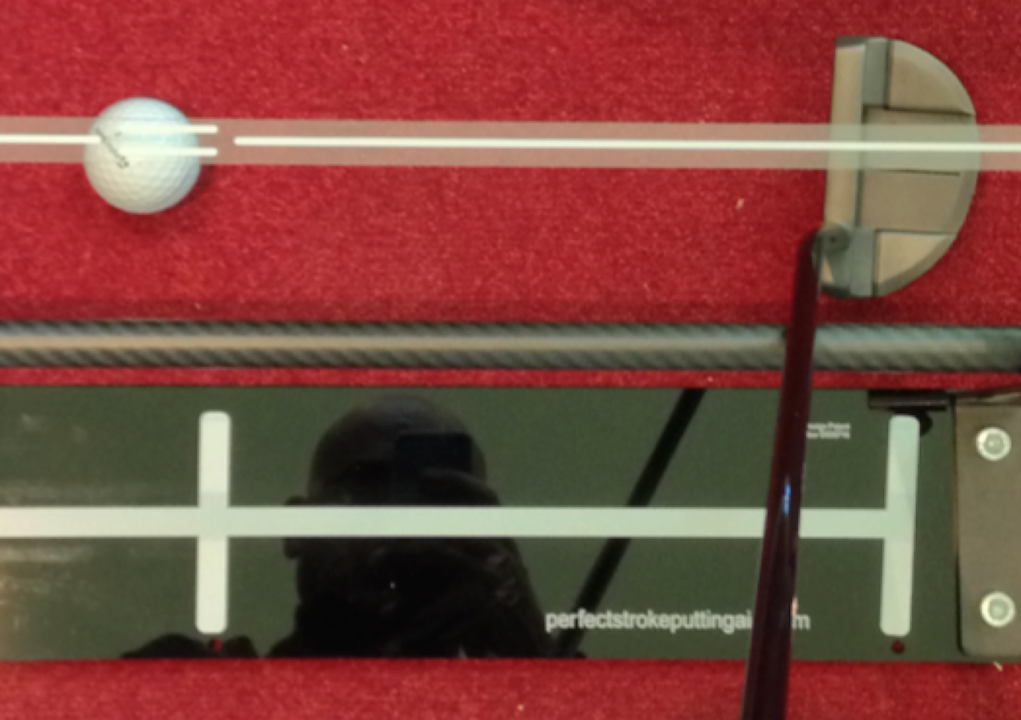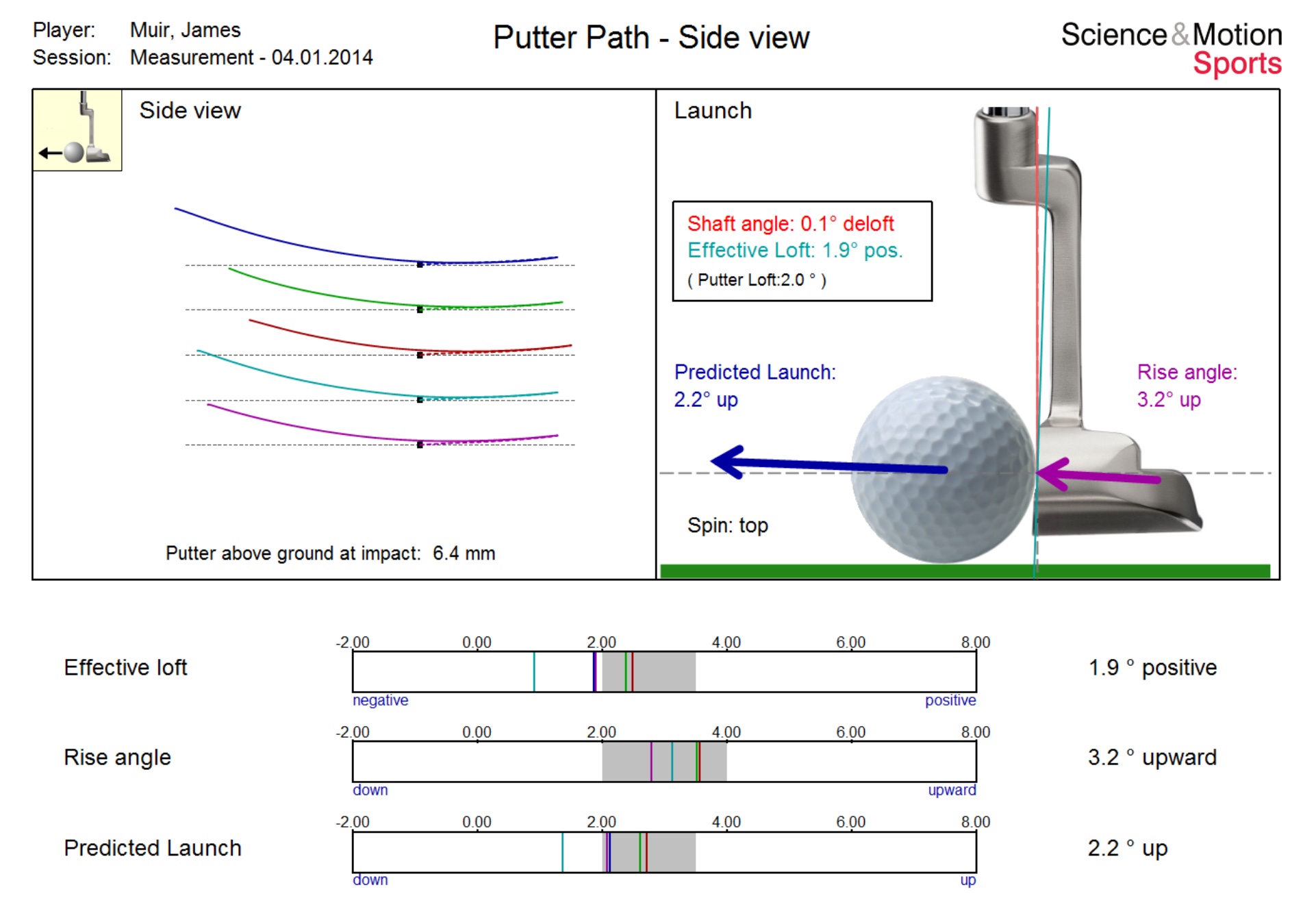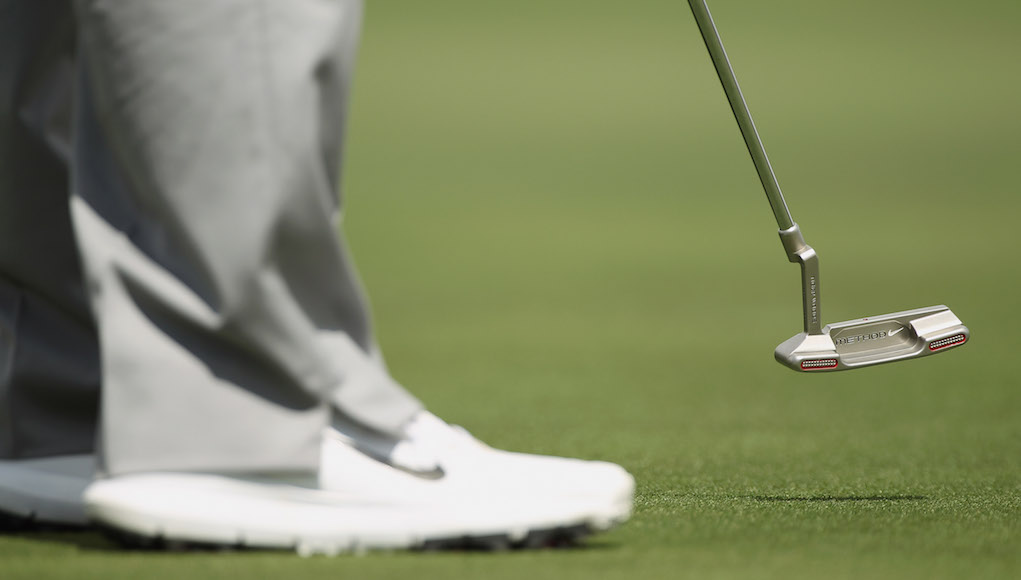Instruction
How much arc should you have in your putting stroke? Well, it depends…

Much has been written over the years regarding putting and the benefits of using a square-to-square putting stroke versus having some arc in the stroke. Personally, I’ve always gravitated toward what I call an “on-plane” putting stroke where the shaft of the club works back and thorough with minimal face rotation. In my opinion, this makes the stroke more natural and requires fewer manipulations from the player.
In order to train players to use this stroke, I first use the SAM Puttlab to help them understand their arc and rotation tendencies. From there, I begin to tighten up any loose motions using a simple on-plane putting stroke trainer I have called the Perfectstroke Putting Aid. Most people have trouble with too much face rotation and this aid tends to help keep it under control.
Here’s what the training aid look like from address.

There’s a rail that the putter shaft rides back and forth along keeping it on plane, while the clear white line helps to show face rotation. While I make my backstroke you will notice a few things…

- The shaft remains on the rail and has remained “on-plane.”
- The head has shifted inward on a very slight arc.
- The face has rotated open slightly.
So how can you apply this to your stroke?
When you move the putter back and through, you’ll always see some type of arcing unless you train yourself to NOT have this motion. This is because the shaft lies on an inclined plane, naturally making the putter head move in the manner shown above.
Note: The more upright your putter, the easier it is to make a straight-back, straight-through stroke.
As the putter moves, you will also see a touch of face rotation; this is normal as long as it’s not forced. We want the stroke to be as natural as possible. Putters with different toe hangs allow for different amounts of rotation. Whether you prefer less or more arc will determine what style of putter you should use. Mallets tend to not open up as much, while putters with more toe hang tend to open much more.
SAM Putt lab can help immensely by not only identifying your stroke proportions, but also helping to fit you into the putter you prefer.

I try to train the stroke on the Perfectstroke and then see how this affects putter head rotation. Using the SAM I can fine tune the face rotation and from there the stroke is much simpler to repeat.
Here are my keys to making a more “on-plane” putting stroke:
- Practice with a training aid such as the Perfectstroke, other arc trainers, or using a bench — anything with a straight edge that the shaft can follow to train yourself to keep your stroke more “on-plane.”
- Focus on how to make this stroke and what you feel in order to do so.
- Try to curb excessive face rotation by experimenting with putters that have less toe hang, face-balanced putters and/or by using larger grips.
- If doing this does not seem to help, practice putting with your left hand only and you will learn to curb your overactive face rotation.
As always, enjoy the experimenting process; it’s part of the fun!
- LIKE81
- LEGIT8
- WOW2
- LOL3
- IDHT1
- FLOP6
- OB4
- SHANK44
Instruction
Clement: Laid-off or perfect fade? Across-the-line or perfect draw?

Some call the image on the left laid off, but if you are hitting a fade, this could be a perfect backswing for it! Same for across the line for a draw! Stop racking your brain with perceived mistakes and simply match backswing to shot shape!
- LIKE0
- LEGIT0
- WOW0
- LOL0
- IDHT0
- FLOP0
- OB0
- SHANK1
Instruction
The Wedge Guy: The easiest-to-learn golf basic

My golf learning began with this simple fact – if you don’t have a fundamentally sound hold on the golf club, it is practically impossible for your body to execute a fundamentally sound golf swing. I’m still a big believer that the golf swing is much easier to execute if you begin with the proper hold on the club.
As you might imagine, I come into contact with hundreds of golfers of all skill levels. And it is very rare to see a good player with a bad hold on the golf club. There are some exceptions, for sure, but they are very few and very far between, and they typically have beat so many balls with their poor grip that they’ve found a way to work around it.
The reality of biophysics is that the body moves only in certain ways – and the particulars of the way you hold the golf club can totally prevent a sound swing motion that allows the club to release properly through the impact zone. The wonderful thing is that anyone can learn how to put a fundamentally sound hold on the golf club, and you can practice it anywhere your hands are not otherwise engaged, like watching TV or just sitting and relaxing.
Whether you prefer an overlap, interlock or full-finger (not baseball!) grip on the club, the same fundamentals apply. Here are the major grip faults I see most often, in the order of the frequency:
Mis-aligned hands
By this I mean that the palms of the two hands are not parallel to each other. Too many golfers have a weak left hand and strong right, or vice versa. The easiest way to learn how to hold the club with your palms aligned properly is to grip a plain wooden ruler or yardstick. It forces the hands to align properly and shows you how that feels. If you grip and re-grip a yardstick several times, then grip a club, you’ll see that the learning curve is almost immediate.
The position of the grip in the upper/left hand
I also observe many golfers who have the butt of the grip too far into the heel pad of the upper hand (the left hand for right-handed players). It’s amazing how much easier it is to release the club through the ball if even 1/4-1/2″ of the butt is beyond the left heel pad. Try this yourself to see what I mean. Swing the club freely with just your left hand and notice the difference in its release from when you hold it at the end of the grip, versus gripping down even a half inch.
To help you really understand how this works, go to the range and hit shots with your five-iron gripped down a full inch to make the club the same length as your seven-iron. You will probably see an amazing shot shape difference, and likely not see as much distance loss as you would expect.
Too much lower (right) hand on the club
It seems like almost all golfers of 8-10 handicap or higher have the club too far into the palm of the lower hand, because that feels “good” if you are trying to control the path of the clubhead to the ball. But the golf swing is not an effort to hit at the ball – it is a swing of the club. The proper hold on the club has the grip underneath the pad at the base of the fingers. This will likely feel “weak” to you — like you cannot control the club like that. EXACTLY. You should not be trying to control the club with your lower/master hand.
Gripping too tightly
Nearly all golfers hold the club too tightly, which tenses up the forearms and prevents a proper release of the club through impact. In order for the club to move back and through properly, you must feel that the club is controlled by the last three fingers of the upper hand, and the middle two fingers of the lower hand. If you engage your thumbs and forefingers in “holding” the club, the result will almost always be a grip that is too tight. Try this for yourself. Hold the club in your upper hand only, and squeeze firmly with just the last three fingers, with the forefinger and thumb off the club entirely. You have good control, but your forearms are not tense. Then begin to squeeze down with your thumb and forefinger and observe the tensing of the entire forearm. This is the way we are made, so the key to preventing tenseness in the arms is to hold the club very lightly with the “pinchers” — the thumbs and forefingers.
So, those are what I believe are the four fundamentals of a good grip. Anyone can learn them in their home or office very quickly. There is no easier way to improve your ball striking consistency and add distance than giving more attention to the way you hold the golf club.
More from the Wedge Guy
- The Wedge Guy: Golf mastery begins with your wedge game
- The Wedge Guy: Why golf is 20 times harder than brain surgery
- The Wedge Guy: Musings on the golf ball rollback
- LIKE87
- LEGIT13
- WOW6
- LOL1
- IDHT0
- FLOP4
- OB1
- SHANK8
Instruction
Clement: Stop ripping off your swing with this drill!

Not the dreaded headcover under the armpit drill! As if your body is defective and can’t function by itself! Have you seen how incredible the human machine is with all the incredible feats of agility all kinds of athletes are accomplishing? You think your body is so defective (the good Lord is laughing his head off at you) that it needs a headcover tucked under the armpit so you can swing like T-Rex?
- LIKE0
- LEGIT2
- WOW2
- LOL0
- IDHT0
- FLOP0
- OB0
- SHANK2
-

 19th Hole2 weeks ago
19th Hole2 weeks agoDave Portnoy places monstrous outright bet for the 2024 Masters
-

 19th Hole4 days ago
19th Hole4 days agoJustin Thomas on the equipment choice of Scottie Scheffler that he thinks is ‘weird’
-

 19th Hole2 weeks ago
19th Hole2 weeks agoTiger Woods arrives at 2024 Masters equipped with a putter that may surprise you
-

 19th Hole4 days ago
19th Hole4 days ago‘Absolutely crazy’ – Major champ lays into Patrick Cantlay over his decision on final hole of RBC Heritage
-

 19th Hole2 weeks ago
19th Hole2 weeks agoTwo star names reportedly blanked Jon Rahm all week at the Masters
-

 19th Hole1 week ago
19th Hole1 week agoReport: LIV Golf identifies latest star name they hope to sign to breakaway tour
-

 19th Hole2 weeks ago
19th Hole2 weeks agoNeal Shipley presser ends in awkward fashion after reporter claims Tiger handed him note on 8th fairway
-

 19th Hole1 week ago
19th Hole1 week agoBrandel Chamblee has ‘no doubt’ who started the McIlroy/LIV rumor and why
























Zinger Pinger
Apr 15, 2017 at 2:03 am
I thought that the most expensive, exotic, studio-designed putters machined from a solid block of sooft virgin 303 SS and proper heel-toe weighting design shapes would automatically bring itself to square at impact…. and even control distance …. after all, shouldn’t a $750 custom putter do all that for you …?!!
PGFREE
Apr 4, 2017 at 7:02 pm
Ian NAILED IT!!
Dill Pickelson
Mar 30, 2017 at 10:59 pm
i would characterize it differently. my data shows it’s not that people arc too much as tiger arc’d more than almost every tour pro. the issue is people don’t square the face at impact. the average is 2 degrees open at impact (e.g. 50/50 from 7ft or so). it’s rare for someone to over rotate to closed at impact. it’s pretty impossible to have people restrict the arc on the backswing and then somehow naturally square it. let it open, let it close and just put the ball in the right place. the key is in the shoulders moving naturally (no rocking!) and the elbows also arcing’, bottoming BEHIND the ball not at it, etc…
Ian
Mar 28, 2017 at 8:52 am
When my putting is off I try focus only on distance control. When my putting is on I try focus only on distance control.
Kevin
Mar 28, 2017 at 1:01 pm
Excessive Face Rotation is the biggest culprit in solid contact for most players. Arc, is a function of length of putt/backstroke. I do believe on longer putts the stroke has a tendency to move toward the inside. Although, a 3 time winner on PGA Tour told me his coaches said he was taking the putter slightly outside. Whatever you do hit solid putts and concentrate on square and center contact!!
Mat
Mar 28, 2017 at 2:24 pm
Right on, Ian.
First putt is all distance control. Sometimes it’ll go in. The skill is ensuring the second putt goes in. If putt two is difficult, putt one failed. And of course, solid contact is the best way to get consistency in face response for distance control.
For whatever it’s worth, I’ve found for myself that I putt best with my right hand on top, like moving a computer mouse. Left hand stabilises under. Try things, but base your findings on how that distance control works!
Hans
Mar 29, 2017 at 1:37 pm
For a lot of players, distance control is the last thing to work on. Telling someone that can’t make a consistent stroke to worry about distance control first is waste of time. I used to be a bad putter. I learned to fix my alignment and get my stroke consistent and within no time my distance control improved tremendously. That’s because if you have problems with stroke you don’t get the consistent feedback needed to get the feel for distance control. Fix your stroke and distance control is easy. Once you are already a good consistent putter, sure work on distance control to refine your feel. Work on distance control is good advice for those that already good at putting. But for many with putting issues, fix the stroke first and distance control will follow.